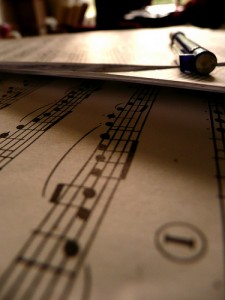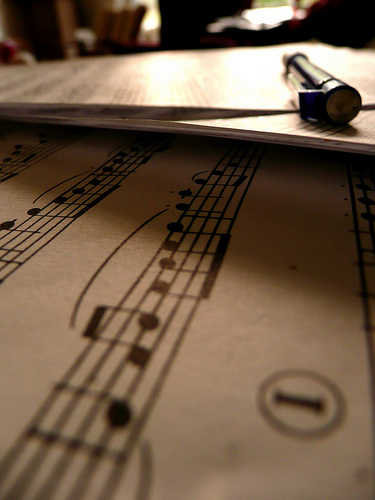 I was talking to a parent after teaching a lesson yesterday, and she told me that her older daughter (who plays a few different band instruments, but is not currently taking piano lessons) is attending a band camp for high schoolers this week. Upon arrival, the camp gave her daughter a theory placement test, and she scored a 2B (I’m not sure what leveling system they were using, but her mother had expected her to score higher). Her mother was a little perturbed because she has paid for many years of lessons for her daughter, but only a few of her daughter’s past teachers taught theory as component of taking private lessons. She wondered, shouldn’t my daughter have gotten more theory training than this? What have I been paying all this money and time for?
I was talking to a parent after teaching a lesson yesterday, and she told me that her older daughter (who plays a few different band instruments, but is not currently taking piano lessons) is attending a band camp for high schoolers this week. Upon arrival, the camp gave her daughter a theory placement test, and she scored a 2B (I’m not sure what leveling system they were using, but her mother had expected her to score higher). Her mother was a little perturbed because she has paid for many years of lessons for her daughter, but only a few of her daughter’s past teachers taught theory as component of taking private lessons. She wondered, shouldn’t my daughter have gotten more theory training than this? What have I been paying all this money and time for?
This conversation got me thinking about our responsibility as teachers. A basic definition of music theory is the study of how music works. A student having little understanding of theory is missing a huge piece of the pie.
Teaching Music Theory: A Responsibility
Teachers of any subject area have a responsibility to give their students a well-rounded education in the area in which they are qualified. The students and parents do not always know what constitutes a good music education because they are often not trained in the area of music. The teacher decides what should be taught, because they are qualified in that subject area.
Music theory is an integral part of music education, even if it is “just” private lessons. It is our responsibility to teach how music works just as much as it is our responsibility to teach how to read and make music on an instrument. To claim music theory is not necessary for learning a musical instrument is nearly as ludicrous as for a math teacher to claim that you don’t need to know how algebra works, you just have to learn to do it. C’est bizarre. Theory and performance go hand-in-hand, inseparable. For example, knowing how to identify and name chords is important for being able to quickly recognize them when you are playing music. It’s about understanding the music that you are playing.
The good musicians are those who understand how music works. The good music teachers are those who teach how music works.
Incorporating Music Theory: What Does it Look Like?
Music theory includes studying the basic elements of music: rhythm, melody, harmony, structure, form, texture, etc. At the most basic level, teaching theory might be simply teaching the names of the various rhythmic values (quarter note, half note, etc.) and learning how to draw them. As the student becomes more advanced, they are taught about scales, key signatures, chords, modes (major, minor, and others). Other concepts include identifying patterns and thematic motives, understanding differences in style and genre (Baroque vs. Romantic; jazz vs. classical), and understanding formal structures (binary form, ternary form, sonata-allegro form, fugue, etc.).
There are various ways to incorporate theory into the private lesson:
- Assign worksheets from a theory book. Give the students a theory book, and assign them to complete 1 to 3 pages each week. Be sure to take the time to go over the worksheets together and correct any mistakes. I would not recommend taking more than 5 minutes of the lesson time correcting theory sheets. If it begins to take more than 5 minutes, assign less. Or, don’t correct every problem on the page: just scan to see whether the student seems to understand the overall concept or not.
- Teach theory through the student’s assigned pieces. This method requires great diligence on the part of the teacher. You must always keep theory in the front of your mind, and consciously make an effort to make time for discussing theory. For example, if you notice that the student’s piece this week introduces the V7 chord for the first time, do not neglect to take the time to make sure the student understands the difference between the I chord and the V7, and the harmonic function of the chords, and how to build them in various keys.
- Incorporate games and other activities into the lesson. Learning theory can be lots of fun! Create your own, or get ideas from books or other teachers. To get started, check out my printable board game here, and also check out the Links page to find more websites where music teachers share their resources and ideas.
- Focus on theory during group lessons. Having group lessons is the perfect opportunity to focus on theory, and teaching in groups can be very effective. Complete worksheets together as a group, and then play some theory games to test their understanding.
Using a combination of the above methods will yield the best results.
Final Thoughts
- Students are never too young for theory. Even beginners who are learning to play short tunes on the black keys can practice writing quarter notes. It’s a great way to reinforce basic concepts. The importance of learning how to write notes, clefs, and chords should not be undermined.
- Make time for theory. The number one difficulty in incorporating theory is — you guessed it — not having enough time in the private lesson. Music theory is important, however, so one must make time for it. Besides, in the long run, teaching theory pays off because it helps students so much with their playing as they progress. =)
Photo credit: S. Parker | CC 2.0



Wonderful post! I completely agree. We are truly cheating our students if we are not giving them a music theory education.
it’s really helps me a lot.. thanks for the information.
Thank you for this post! I am amazed sometimes by how little my students, who have had other musical experience, know of music theory. I was blessed enough to have a piano teacher who had students stay extra time after lessons for a separate theory study. It was mostly self-guided, but the teacher was there to answer questions. I had a foundation in theory when I got to college that most other students weren’t lucky enough to have.
Thanks for posting this!!
I am a big believer in making time for theory. But I also understand that it can be really challenging sometimes! It’s especially hard to make time when you have enthusiastic players who love to learn songs. I try to make at least 5 minutes for theory games or worksheets and whenever possible, I will point out theory concepts inside the music.
Recently, I started offering once a week group theory lessons for just $20 per student. I have 4 kids coming regularly, and I’m so glad. 5 minutes and a sprinkling of theory ideas in lessons are NOT enough for making a good student of Music Theory. You need to regularly reinforce the ideas so that it starts to become part of their musical language.